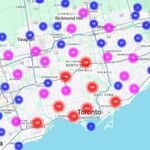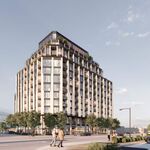Stephen Harper, the Prime Minister, and Dalton McGuinty, the Ontario Premier, pledged nearly a billion dollars for a brand new light rail line in Scarborough yesterday, but their gala announcement at a streetcar maintenance shop was a telling statement about the politics of securing funding for public transit Toronto.
The smiling Prime Minister and Premier stepped off clanging Toronto Transit Commission streetcar almost an hour behind schedule and without Mayor David Miller, who was relegated to the audience.
And Mr. McGuinty couldn’t resist ribbing the Toronto’s Mayor for requesting funding for a fleet of streetcars to replace the aging red rockets on top of investments in new transit lines – like Sheppard East, for which $950 million was pledged yesterday.
“You working for Miller?” the chuckling Premier wisecracked when a reporter asked about a looming deadline to place a $1.2-billion order for the next generation of Toronto streetcars. “We just got another announcement out the door for God sakes and you’re after the next one.”
Mr. McGuinty opened his remarks with a playful reminder that Ontario recently committed $9 billion to fully fund the new Finch and Eglinton Avenue light rail lines, as well as an overhaul of the Scarborough RT system.
“Between you and me, at the time of that announcement I thought to myself ‘Surely, this is going to satisfy Miller.’ But that, my friends, was not to be the case,” the Premier quipped. “Our Mayor is nothing if not dogged and determined when it comes to improving transit for Torontonians. And sadly for me, he continues to make a very compelling case.”
MORE: Peter Kuitenbrouwer’s series on Transit City.
The Prime Minister, meanwhile, touted the manufacturing jobs that will be created at Bombardier from the 63 trams included in the price tag of the Sheppard line.
But unless the federal and provincial governments step up with $1.2 billion in economic stimulus money so the TTC can order 204 replacement streetcars from Bombardier by June 27, it may not get any vehicles to run on the new lines by the time they are completed.
The way the contract with the Canadian manufacturer is structured, the TTC can only exercise an option to purchase up to 400 streetcars for new routes if it orders the replacement fleet first.
Neither Mr. Harper nor Mr. McGuinty would make any promises yesterday.
“We’d love to be able to find a way to do this,” the Premier said. “I can’t say yes and I can’t say no, let me just tell you that I see it in a positive light.”
Mr. Miller, for his part, showed nothing but gratitude.
“I think it’s fantastic news for Toronto. We should have been doing this 20 years ago,” he said. “We should certainly say thank you and I am. Thank you Prime Minister Harper. Thank you Premier McGuinty.”
Work on the Sheppard LRT – which will run from Don Mills subway station to Meadowvale road – will begin this summer, creating 95,000 jobs.
The federal government is kicking in a third of the $950-million price tag from its slow-to-flow Building Canada infrastructure fund, while the province will pick up the rest.
The Mayor said he remains “optimistic” the federal and provincial governments will come through with stimulus money for the replacement vehicles.
“I don’t think people should let that issue obscure the importance of today’s announcement,” Mr. Miller said. “Yes, we’re still working on the funding for the 204 option cars, but both the Premier and the Prime Minister left the door open on that. That’s all I needed to hear today.”
Money for 263 trams to operate on the Sheppard, Finch and Eglinton Transit City lines is included in their funding, but unless they are ordered by the end of the year they may not arrive on time.
TTC general manager Gary Webster said yesterday that if the order for replacement streetcars doesn’t go through, the entire procurement process for the new light rail vehicles would have to begin anew, potentially delaying delivery.
“You’d have to completely start over with a new procurement process to buy streetcars for Transit City,” Mr. Webster said. “The governments know that… I was encouraged by what they had to say.”
Ontario New Democratic Party leader Andrea Horvath urged the province to stop politicizing the streetcar contract, which has the potential to secure jobs at Bombardier’s Thunder Bay plant, as well as in the beleaguered auto parts sector.
“They’re playing with people’s lives, they’re playing with people’s futures,” she said. “They’re causing a great deal of consternation and upset for families not only in Thunder Bay, but for transit supporters here in Toronto and the.”
Gerrard Kennedy, a federal Liberal critic, accused the Prime Minister of getting a “free ride” on the tailwinds of Ontario’s significant investments in Toronto transit.
“They’re only paying 10% of the cost of new transit in Toronto. That’s all it’s coming too,” Mr. Kennedy said. “If people think mistakenly that this is Toronto getting its share of stimulus funds, it’s just dead wrong. They haven’t yet got a nickel of from the new money that was voted by parliament.”





